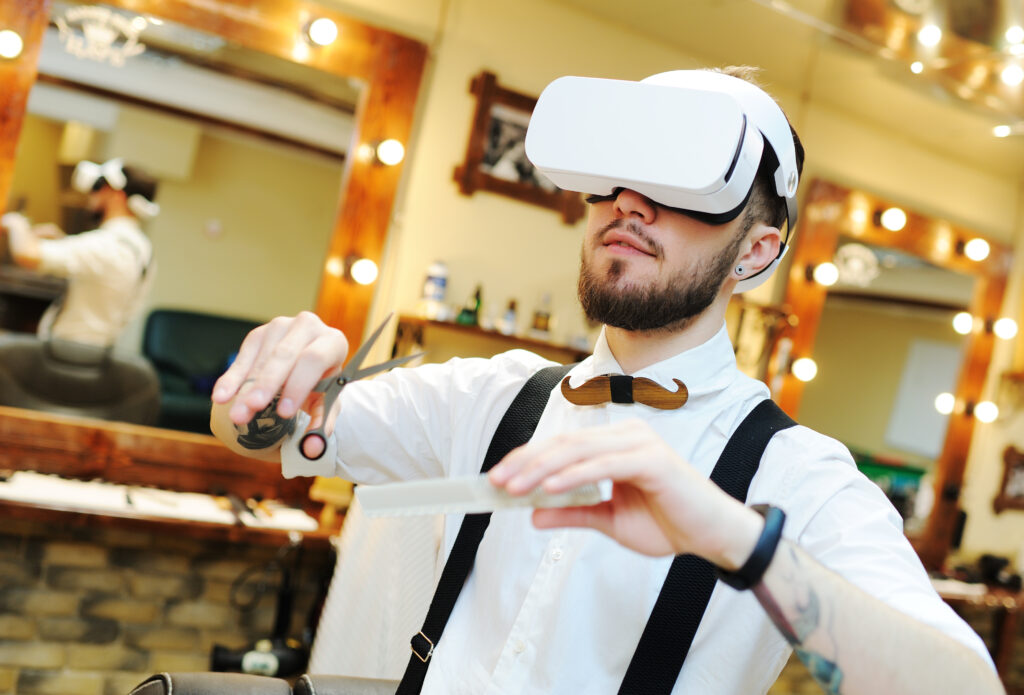“The future of VR is being immersed into an environment blending physical and digital worlds, where users interact via a headset, their computer, or their mobile device to role play with an avatar or learn a new skill.” – Christopher Dede, Harvard School of Education.
Imagine an employee training program that enhances staff skills, captivates their attention, and accelerates proficiency. Virtual Reality (VR) training is not just a concept anymore; it’s a transformative reality. When employers leverage immersive technology, they provide employees with realistic and engaging learning experiences, redefining how they acquire new skills.
This innovative approach simulates diverse work scenarios, allowing trainees to interact with virtual counterparts, practice complex tasks, and hone soft skills like customer service and conflict resolution.
This article looks at how virtual reality training benefits employers and employees by examining its applications, focusing on building employee skills in retail settings.
What is Virtual Reality Training?
Virtual Reality (VR) training is an innovative approach that leverages immersive technology to provide employees with realistic and engaging learning experiences. It simulates various work scenarios and environments, allowing trainees to interact with virtual counterparts, handle complex tasks, and practice soft skills like customer service and conflict resolution.
VR training is particularly valuable for frontline workers in retail, healthcare, and logistics industries, as it accelerates proficiency, enhances employee retention, and offers a cost-effective solution for continuous skill development. Companies like Walmart, Bank of America, and MGM Resorts have embraced VR training to prepare their employees effectively and attract potential talent.

Source: VIAR360
How Does Virtual Reality Training Provide Value to Employers and Employees?
Value For Employers:
Virtual Reality (VR) training provides significant value to employers in several ways. Firstly, it offers cost-effective training solutions, reducing the expenses associated with traditional training methods. Companies can use VR to create immersive simulations for various job roles, enabling employees to practice and develop their skills in a controlled virtual environment. This leads to accelerated proficiency, improved operational efficiency, and better-prepared employees.
Additionally, VR training collects valuable data on employee skills and capabilities, allowing employers to assess readiness effectively and tailor training programs to specific needs. Furthermore, VR can serve as a powerful recruiting tool, attracting potential employees with innovative and engaging training experiences, thus addressing workforce challenges.
Value For Employees:
VR training enhances the learning experience for employees by providing realistic and engaging simulations within a safe, low risk environment. It allows them to immerse themselves in job-related scenarios, practice tasks, and develop soft skills such as customer service and conflict resolution. This improves their confidence and accelerates job proficiency before working in-store. VR training is enjoyable and memorable, making it an effective learning tool.
Moreover, employees benefit from the flexibility of VR training, as it can be conducted at their own pace and without disrupting daily operations. In sum, VR training empowers employees to acquire and improve their skills, contributing to their career growth and job satisfaction.
“Fundamentally, our employees were doing all the things we wanted them to do, but there was something missing in our customer interactions. There was not enough of a human connection — so we made it a priority to focus our training on developing empathy.” – Kim Iorns, Director of Learning and Development for H&R Block.
Virtual Reality Training in Retail Workplaces
Realistic Job Expectations
VR training allows new hires to gain a first-person experience of their job site before entering the workplace. They can explore their roles, become familiar with the company’s culture, and acclimate to their positions.
This realistic job preview aids in recruiting and retaining well-informed and dedicated employees, ensuring a consistent brand experience for customers.
Faster Proficiency for Store Operations
Onboarding in retail often involves rapidly learning various tasks, including logistics, operations, and customer interactions. VR training provides lifelike simulations of stores, including seating areas, service counters, and food-prep stations.
Employees can practice in a risk-free VR environment, gaining situational awareness and confidence before facing customers. This accelerates their proficiency and enhances overall customer service quality.
Customer Service and Empathy
VR immerses frontline employees in various customer scenarios, helping them empathize with diverse situations and personality types. In an era of heightened emotions, VR training enables employees to better understand their customers’ perspectives.
For instance, despite not being mandatory, Walmart incorporated VR into its beKIND empathy training, leading to high employee adoption rates and improved soft skills.
Handling Difficult Conversations
VR training allows retail store managers to practice interpersonal skills and leadership tactics, effectively preparing them to handle challenging situations and tough conversations. Managers learn to recognize and respond to problems in ways that diffuse conflicts and overcome challenges. The ability to replay their responses fosters self-awareness and enhances communication skills.
Emergency Preparedness
Training employees to react in rare emergencies, such as store robberies or active shooter scenarios, is challenging. However, VR provides a solution by offering realistic experiences of high-risk situations. This helps employees develop critical de-escalation skills, situational awareness, and emotional preparedness.
Pros & Cons of Implementing Virtual Reality Training at Your Business
Pros:
- Engaging & Safe Learning Experience: VR training is immersive and engaging, making it more enjoyable, safe and memorable for employees.
- Realistic Simulations: It provides practical simulations of job-related scenarios, enabling employees to practice and develop their skills in a controlled environment.
- Accelerated Proficiency: VR training accelerates employee learning, allowing them to become more proficient in their roles more quickly.
- Improved Customer Service: Employees trained in VR are better equipped to handle customer interactions, improving customer service quality.
- Flexible Training: VR training can be conducted at employees’ own pace, offering flexibility in the learning process.
- Cost-Effective: Over time, VR training can reduce training expenses, as it eliminates the need for physical materials and facilities.
Cons:
- Initial Investment: Implementing VR training requires an initial investment in technology and content development, which can be costly.
- Complex Setup: VR systems and software may require technical expertise to implement and administer.
- Limited Accessibility: Not all employees may have access to VR equipment, potentially creating disparities in training opportunities.
- Motion Sickness: Some individuals may experience motion sickness during VR training, affecting the program’s effectiveness.
- Content Development: Creating VR training content can be time-consuming and may require specialized skills.
- Maintenance Costs: Ongoing maintenance and updates for VR equipment and software can add to the long-term expenses.
“Studies show there is better recall and movement when you take off the headset after VR training. If you’re learning with your eyes, your ears, and even your hands and feet, you may be learning — and remembering — in a more complete way.” – (Source: The Washington Post)
Conclusion
Virtual Reality training is revolutionizing the way employees acquire and improve their skills. It brings substantial value to employers and employees by offering immersive learning experiences and practical applications in various industries, particularly in retail.
While it presents several advantages, including cost-effectiveness and accelerated proficiency, businesses must also consider the initial investments and potential limitations when implementing VR training programs. Nevertheless, the future of employee training appears promising as VR continues to gain momentum in the corporate world.
Thank you for reading our article!
TimeWellScheduled is a secure online time and attendance software 100% tailored to meet your scheduling needs! In addition, our cloud-based scheduling solution optimizes employee attendance tracking, simplifies payroll administration, and enhances staff management capabilities. Plus, our service is free for up to 10 employees!
Click here to download our (Excel) employee scheduling template; It’s FREE!






